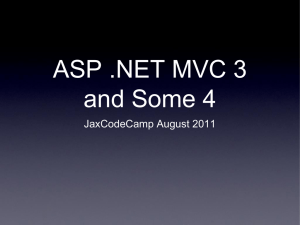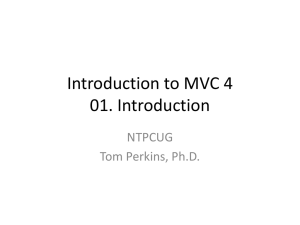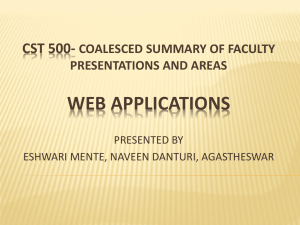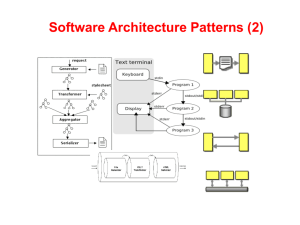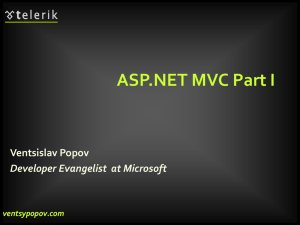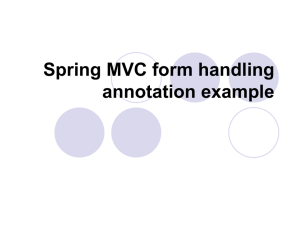SpringMvcPart1
advertisement
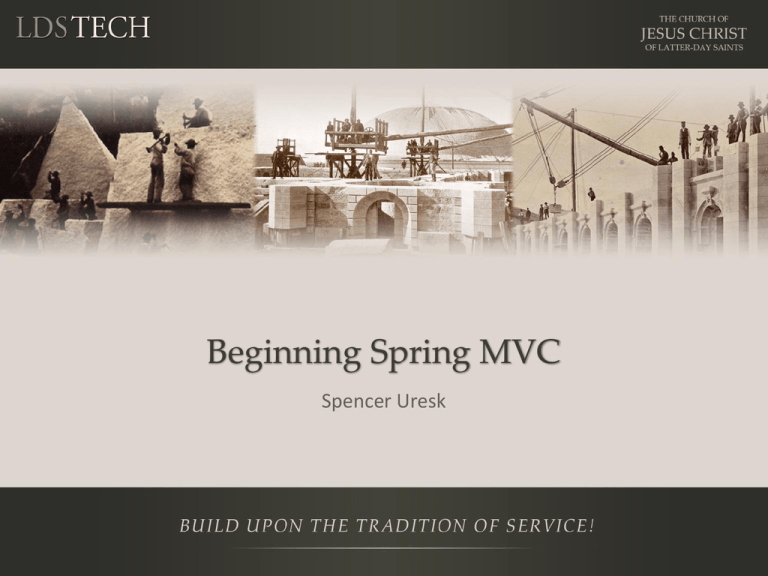
Beginning Spring MVC
Spencer Uresk
Notes
•
•
•
•
•
This is a training, NOT a presentation
Please ask questions
This is being recorded
https://tech.lds.org/wiki/Java_Stack_Training
Prerequisites
– Basic Java
– Installed LDSTech IDE (or other equivalent)
– Spring, Servlet, and JSP Trainings
A Note About Security
• The scope of this training is limited to teaching you how
to use Spring MVC
• The way we output values in JSPs is insecure – they
contain XSS vulnerabilities
• We have documented ways to do this properly:
• https://tech.lds.org/wiki/Intermediate_JSP#Lab_2_Tagli
bs
• http://code.lds.org/mavensites/stack/module.html?module=security-web
Objectives
• By the end of this training, you should:
- Have a general understanding of MVC in
general and Spring MVC in particular
- Understand how Spring MVC is configured and
be able to add it to any project
- Know how to create a simple controller
- Know how to map an incoming request to a
controller
What is MVC?
• Well-established architectural pattern for dealing
with UI
• Model manages the behavior and data of the
application
• View renders the model into UI elements
• Controller processes user inputs and generates a
response by operating on model objects
MVC in a Web Application
• The model is the data and business/domain logic
for your application
• The view is typically HTML generated by your
application
• The controller receives HTTP requests and
decides which domain objects to use to carry out
specific tasks
Benefits of MVC
•
•
•
•
Decoupling views and models
Reduces the complexity of your design
Makes code more flexible
Makes code more maintainable
What is Spring MVC?
• MVC Web Framework
• Developed by the Spring team in response to
what they felt were deficiencies in frameworks
like Struts
• Deeply integrated with Spring
• Allows most parts to be customized (ie, you can
use pretty much any view technology)
• RESTful functionality (URI templates, Content
Negotiation)
Spring MVC Features
• Clear separation of roles
• Simple, powerful annotation-based configuration
• Controllers are configured via Spring, which
makes them easy to use with other Spring
objects and makes them easy to test
• Customizable data binding
• Flexible view technology
• Customizable handler mapping and view
resolution
DispatcherServlet
[1] Copyright © 2004-2010 Rod Johnson, Juergen Hoeller, et al. See copyright
slide for full copyright information.
Adding Spring MVC to a project
• Spring MVC is relatively easy to add to any
existing Spring project
• When you create a Stack Starter (3.x) project, the
default is to include Spring MVC
• But we’ll go through the configuration steps so
you know what is going on
• 3 basic steps
Step 1: Add dependencies
• First, you need to add the Spring MVC
dependency to your web POM
<dependency>
<groupId>org.springframework</groupId>
<artifactId>spring-webmvc</artifactId>
</dependency>
Step 2: Configure web.xml
• We need to define the DispatcherServlet , give it
a name (yourapp in this case), and map it to a url
pattern (/ in this case, which is the default
servlet)
<servlet>
<servlet-name>yourapp</servlet-name>
<servlet-class>org.springframework.web.servlet.DispatcherServlet</servletclass>
<load-on-startup>2</load-on-startup>
</servlet>
<servlet-mapping>
<servlet-name>yourapp</servlet-name>
<url-pattern>/</url-pattern>
</servlet-mapping>
Step 3: Add the configuration file
• We need to create a configuration file name
[servlet-name]-servlet.xml, where [servlet-name]
is the name we gave our servlet in Step 2
(yourapp)
• This is a normal Spring configuration file that
defines a web context
Step 3, Continued
• First, we tell it to look for classes in the
org.lds.yourapp namespace, annotated with
@Controller
<context:component-scan base-package="org.lds.yourapp" use-defaultfilters="false">
<context:include-filter
expression="org.springframework.stereotype.Controller"
type="annotation" />
</context:component-scan>
• We also need to tell Spring MVC that we are
going to configure it via annotations:
<mvc:annotation-driven />
Step 3, Continued
• If you map the DispatcherServlet to the default
servlet (we did), you need to add the following:
<mvc:default-servlet-handler />
• Finally, we need to configure a ViewResolver to
find our JSPs
<bean class="org.springframework.web.servlet.view.InternalResourceViewResolver">
<property name="prefix" value="/WEB-INF/views/"/>
<property name="suffix" value=".jsp"/>
<property name="redirectHttp10Compatible" value="false"/>
</bean>
Hierarchy of Contexts
• When we create the [servlet-name]-servlet.xml
file, we are creating a new Spring context that is
a child of your application context
• It can resolve beans from the root context, but
other contexts can’t resolve beans from it
• You can create as many of these as you need (ie,
you might have another one for web services)
• You need to make sure you don’t redefine beans,
though
Context Hierarchy
a
• DefaultWebContext
•/
b
c
• GWT Context
• /*.gwtrpc
• Web Services
• /ws/
Simple request mapping
• We can do simple mappings to static content in
the xml configuration, which maps /hello to
/WEB-INF/views/hello.jsp
<bean id="helloController"
class="org.springframework.web.servlet.mvc.ParameterizableViewController">
<property name="viewName" value="hello" />
</bean>
<bean class="org.springframework.web.servlet.handler.SimpleUrlHandlerMapping">
<property name="order" value="1" />
<property name="urlMap">
<map>
<entry key="/hello" value-ref="helloController" />
</map>
</property>
</bean>
Simple request mapping
• Thankfully, Spring MVC has a Namespace
Handler to make this simpler.
• The following does the exact same thing:
<mvc:view-controller path="/hello" view-name=“hello" />
Lab 1: Configure a project
• Take a basic project (with no view) created via
Stack Starter
• Add dependencies, web.xml config, and servlet
config
• Add a simple request mapping
• Verify that it works
Simple Controller
• For most cases, you’ll need to create a controller
• Create a class and annotate it with @Controller
• Then, create a method annotated with a
@RequestMapping
package org.lds.yourapp;
@Controller
public class HelloController {
@RequestMapping(value="/")
public String hello() {
return “hello";
}
}
Advanced Request Mapping
• RequestMappings are really flexible
• You can define a @RequestMapping on a class
and all method @RequestMappings will be
relative to it.
• There are a number of ways to define them:
– URI Patterns
– HTTP Methods (GET, POST, etc)
– Request Parameters
– Header values
@RequestMapping – Class level
package org.lds.yourapp;
@RequestMapping("/portfolio")
@Controller
public class PortfolioController {
@RequestMapping("/create")
public String create() {
return “create";
}
}
• The url for this (relative to your context root)
would be: /portfolio/create
@RequestMapping – HTTP Methods
package org.lds.yourapp;
@RequestMapping("/portfolio")
@Controller
public class PortfolioController {
@RequestMapping(value = "/create“, method =
RequestMethod.POST)
public String save() {
return “view";
}
}
• Same URL as the previous example, but responds
to POSTs
@RequestMapping – Request Params
package org.lds.yourapp;
@RequestMapping("/portfolio")
@Controller
public class PortfolioController {
@RequestMapping(value = "/view“, params=“details=all”)
public String viewAll() {
return “viewAll";
}
}
• This will respond to /portfolio/view?details=all
@RequestMapping – URI Templates
package org.lds.yourapp;
@RequestMapping("/portfolio/{id}")
@Controller
public class PortfolioController {
@RequestMapping("/viewProject/{projectId}")
public String viewProject() {
return "viewProject";
}
}
• The url for this (relative to your context root) would be:
/portfolio/1/viewProject/10
• We’ll discuss how to use the values from these
placeholders later
Lab 2: Create a controller
• Create a simple controller for /hello
• Return a jsp
• Experiment with some more advanced request
mappings
Controller Method Arguments
• Sometimes you need access to the request,
session, request body, or other items
• If you add them as arguments to your controller
method, Spring will pass them in
@RequestMapping(value="/")
public String getProject(HttpServletRequest request,
HttpSession session,
@RequestParam(“projectId”) Long projectId,
@RequestHeader("content-type") String contentType) {
return "index";
}
Supported Method Arguments
•
•
•
•
•
•
•
•
•
•
Request/Response objects
Session object
Spring’s WebRequest object
java.util.Locale
java.io.Reader (access to request content)
java.io.Writer (access to response content)
java.security.Principal
ModelMap
org.springframework.validation.Errors
org.springframework.validation.BindingResult
Supported Annotations on params
•
•
•
•
@PathVariable
@RequestParam
@RequestHeader
@RequestBody
Method Arguments (Samples)
• This gives you access to the request/response
and session
@RequestMapping(value="/")
public String getProject(HttpServletRequest request,
HttpServletResponse response,
HttpSession session) {
return "index";
}
Method Arguments (Samples)
• This gives you access to request parameters and
headers
@RequestMapping(value="/")
public String getProject(
@RequestParam Long projectId,
@RequestHeader("content-type") String contentType) {
return "index";
}
Method Arguments (Samples)
• @PathVariable ties dynamic elements of the URI
to method arguments
@RequestMapping(value="/project/{portfolioId}/{projectId}")
public String getProject(
@PathVariable(“projectId”) Long id,
@PathVariable Long portfolioId) {
return "index";
}
The Model
• You populate the view with data by via the
ModelMap or ModelAndView (which has a
ModelMap underneath)
• This is basically a Map
• All attributes are added to the request so that
they can be picked up by JSPs
ModelMap
• Add it as a parameter to your controller method
public String doController(ModelMap modelMap){
modelMap.addAttribute(user);
modelMap.addAttribute(“otherUser”, user);
return “index”;
}
• We’d consume it in our JSP like this:
User: ${user}<br /><br />
Other User: ${otherUser}
ModelAndView
• Combines the model and view into one object
public ModelAndView doController() {
ModelAndView mav = new ModelAndView(“index”);
mav.addObject(user);
mav.addObject(“otherUser”, user);
return mav;
}
• We’d consume it in our JSP like this:
User: ${user}<br /><br />
Other User: ${otherUser}
Lab 3: Putting it all together
• Add a more complex controller that takes a path
param and displays it back to the user
• Also, have it echo back a header
Next Steps
• Part II of this training in 2 weeks
• Spring MVC reference documentation
http://static.springsource.org/spring/docs/3.0.x/
spring-framework-reference/html/mvc.html
Sources
• http://en.wikipedia.org/wiki/Model%E2%80%93
view%E2%80%93controller
• http://en.wikipedia.org/wiki/Spring_Framework#
Model-view-controller_framework
• http://static.springsource.org/spring/docs/3.0.x/
spring-framework-reference/html/mvc.html
Copyright Notice
• 1. DispatcherServlet image copyright info:
•
•
•
Copyright © 2004-2010 Rod Johnson, Juergen Hoeller, Keith Donald, Colin Sampaleanu, Rob
Harrop, Alef Arendsen, Thomas Risberg, Darren Davison, Dmitriy Kopylenko, Mark Pollack, Thierry
Templier, Erwin Vervaet, Portia Tung, Ben Hale, Adrian Colyer, John Lewis, Costin Leau, Mark Fisher,
Sam Brannen, Ramnivas Laddad, Arjen Poutsma, Chris Beams, Tareq Abedrabbo, Andy Clement,
Dave Syer, Oliver Gierke
Copies of this document may be made for your own use and for distribution to others, provided
that you do not charge any fee for such copies and further provided that each copy contains this
Copyright Notice, whether distributed in print or electronically.
http://static.springsource.org/spring/docs/3.0.x/spring-framework-reference/html/mvc.html#mvcservlet
